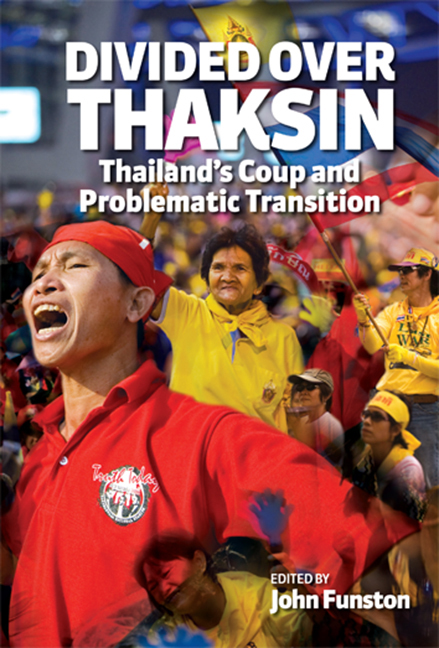Book contents
- Frontmatter
- Contents
- List of Tables and Figures
- List of Contributors
- Preface
- Introduction
- 1 Political Contests in the Advent of Bangkok's 19 September Putsch
- 2 The Tragedy of the 1997 Constitution
- 3 The NESAC, Civil Society, Good Governance and the Coup
- 4 Military Coup and Democracy in Thailand
- 5 Deconstructing the 2007 Constitution
- 6 Thailand's 2007 Constitution and Re-Emerging Democracy: Will Political Polarization Continue?
- 7 Untying the Gordian Knot: The Difficulties in Solving Southern Violence
- 8 Another Country: Reflections on the Politics of Culture and the Muslim South
- 9 Governance in the South: Is Decentralization an Option?
- 10 Tradition and Reform in Islamic Education in Southern Thailand
- 11 The Economy under the Thaksin Government: Stalled Recovery
- 12 The Thai Economy after the Coup
- 13 The Impact of Political Uncertainty on Business
- Index
2 - The Tragedy of the 1997 Constitution
Published online by Cambridge University Press: 21 October 2015
- Frontmatter
- Contents
- List of Tables and Figures
- List of Contributors
- Preface
- Introduction
- 1 Political Contests in the Advent of Bangkok's 19 September Putsch
- 2 The Tragedy of the 1997 Constitution
- 3 The NESAC, Civil Society, Good Governance and the Coup
- 4 Military Coup and Democracy in Thailand
- 5 Deconstructing the 2007 Constitution
- 6 Thailand's 2007 Constitution and Re-Emerging Democracy: Will Political Polarization Continue?
- 7 Untying the Gordian Knot: The Difficulties in Solving Southern Violence
- 8 Another Country: Reflections on the Politics of Culture and the Muslim South
- 9 Governance in the South: Is Decentralization an Option?
- 10 Tradition and Reform in Islamic Education in Southern Thailand
- 11 The Economy under the Thaksin Government: Stalled Recovery
- 12 The Thai Economy after the Coup
- 13 The Impact of Political Uncertainty on Business
- Index
Summary
One of the first acts of Thailand' coup leaders after seizing power on 19 September 2006 was to abrogate the 1997 constitution. I regret to say goodbye to this constitution, which I have read in parts and in entirety time and again for almost ten years now. I harbour nowhere near the expertise of legal luminaries such as Professor Borwornsak Uwanno or Dr Wissanu Kruea-ngam, who can seemingly write constitutions overnight. Nor have I been an able practitioner in the league of Ajarn Gothom Arya, a fellow participant in this conference. Ajarn Gothom was secretary-general of the Election Commission established by the constitution, and did an excellent job in that first commission. But I did have a small part in my own way in seeing the constitution through in September 1997 when I was in London doing a Ph.D. I launched a campaign online which ended up with 3,500 signatures, mostly from people overseas, who wanted to endorse the constitution. Since then I have paid close attention to the way that constitution was implemented.
BACKGROUND OF THE 1997 CONSTITUTION
Let me begin by discussing the context of the 1997 constitution. Thailand has a long history of constitution-making. There have now been sixteen constitutions in seventy-four years — many constitutions. As recently as the 1970s, it had a constitution almost every other year, in 1972, 1976, and 1978. But the 1978 constitution was important, because it lasted for several years, and provided the rules that underpinned elections in 1979, 1983 and 1986. It was also the basis through which General Prem Tinsulanonda became prime minister from 1980–88.
The constitution of 1978 emerged from the turbulent democratic interlude between 1973 and 1976, and further instability in 1977 that led to General Kriangsak Chamanand' coup. The constitution had bicameral arrangements but with an appointed Senate. There were 252 appointed senators, obviously dominated by the military, and 301 House of Representatives members of parliament (MPs). General Prem was nominated by parliament and accepted the premiership. He was never directly elected.
The fact that the prime minister was not elected — and in addition came from the military — became a sticking point, and the main drawback of this constitution.
- Type
- Chapter
- Information
- Divided Over ThaksinThailand's Coup and Problematic Transition, pp. 27 - 37Publisher: ISEAS–Yusof Ishak InstitutePrint publication year: 2009

